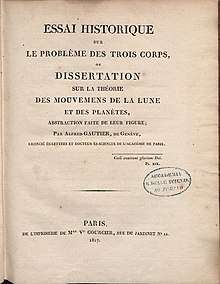Jean-Alfred Gautier
Jean-Alfred Gautier or Alfred Gautier[1] (17 July 1793 – 30 November 1881) was a Swiss astronomer.
Jean-Alfred Gautier | |
|---|---|
| Born | 17 July 1793 Cologny (Switzerland) |
| Died | 30 November 1881 (aged 88) Geneva (Switzerland) |
| Other names | Alfred Gautier |
| Citizenship | |
| Alma mater | University of Geneva, University of Paris |
| Known for | Research on concomitance between sunspot cycle period and geomagnetic activity |
| Spouse(s) | Angélique Frossard de Saugy (1826), Louise Cartier (1849) |
| Scientific career | |
| Fields | Mathematics, astronomy |
| Institutions | Observatory of Geneva, University of Geneva |
| Thesis | Essai historique sur le problème des trois corps (1817) |
| Influences | Laplace, Lagrange and Legendre |
| Influenced | Emile Plantamour |

Biography
He was born in Cologny. He was the son of François Gautier, merchant, and of Marie de Tournes.
He studied astronomy at the University of Geneva, then at the University of Paris. He was awarded a doctorate in celestial mechanics in Paris in 1817; his thesis was entitled Historical essay on the problem of three bodies. His academic advisors were Laplace, Lagrange and Legendre. In 1818 he worked in England with Herschel.[2]
Back in Geneva in 1819, he was appointed astronomy professor then, in 1821, professor of advanced mathematics at the University of Geneva and director of the Observatory of Geneva. He had a new building constructed on the site in 1830 which was equipped with new instruments: an equatorial of Gambey (fr) and a meridian circle.[3]
In 1839, visual impairments prevented him from continuing his career and he gave up his chairs to one of his pupils, Emile Plantamour.[4]
In 1852, within a year of the publication of Schwabe's results, Gautier and three other researchers (Edward Sabine, Rudolf Wolf and Johann von Lamont) announced independently that the sunspot cycle period was absolutely identical to that of geomagnetic activity.[5][3][6]
He married in 1826 Angélique Frossard de Saugy, then in 1849 Louise Cartier.[3] He had no child.
Jean-Alfred Gautier died in Geneva on 30 November 1881.
References
- Library of Congress Name Authority File
- SpringerReference
- Historischen Lexikon der Schweiz
- Thomas Hockey; Katherine Bracher; Marvin Bolt; Virginia Trimble; Richard Jarrell; JoAnn Palmeri; Jordan D. Marché; Thomas Williams; F. Jamil Ragep (18 September 2007). Biographical Encyclopedia of Astronomers. Springer. pp. 411–. ISBN 978-0-387-30400-7.
- Gautier, Alfred (1852). "Notice sur quelques recherches récentes, astronomiques et physiques, relative aux apparences que présente le corps du soleil" [Notice on some recent astronomical and physical investigations regarding appearances that the body of the sun shows]. Bibliothèque Universelle de Genève: Archives des sciences physiques et naturelles (in French). 20: 177–207, 265–282. On pp. 189–190, after discussing Schwabe's discovery of the solar cycle, Gautier presents Lamont's findings on the relation between the solar cycle and the periodic variations in the magnetic declination. Gautier mentions that the Austrian astronomer Augustin Reslhuber (1808–1875) confirmed Lamont's findings. (Reslhuber's confirmation appeared in: Reslhuber, A. (1852). "Ueber die vom Dr. Lamont beobachtete zehn-jährige Periode in der Größe der täglichen Bewegung der Declinationsnadel" [On the ten-year period in the magnitude of the daily movement of the declination needle, which was observed by Dr. Lamont]. Annalen der Physik. 2nd series (in German). 85: 412–420.)
- National Center for Atmospheric Research